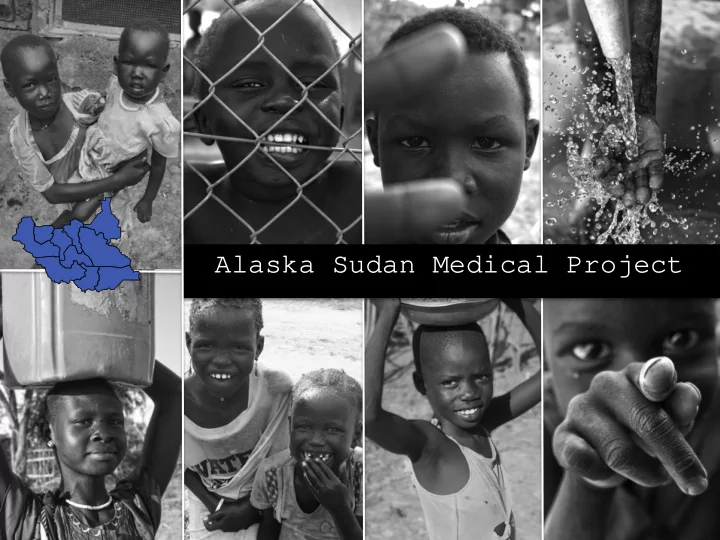

Alaska Sudan Medical Project ALASKA SUDAN MEDICAL PROJECT
Sudan South Sudan Ethiopia CAR Kenya Uganda DRC 2
Old Fangak Nestled between the White Nile and the El Zaref rivers, in the Sudd, one of the largest swamp in the world.
Old Fangak, Jonglei State Remote and isolated Home to the Nuer people Only accessible by boat Largely untouched by aid or small aircraft organizations Population at beginning Current population of project (2008): 5000 (2016): 45,000 +
Key Demographics: Population: 8-12 million Age Structure: 65% of people are 24 or younger Median Age: 17 Facts & Figures: Worlds most failed state • Worlds most corrupt state • 2 nd most violent country in the world (after Syria) • Highest illiteracy rate in the world • Highest maternal fatality rate in the world • Women more likely to die in childbirth than to get an • education 2 in 5 people country-wide don’t have access to clean • water 2.2 million displaced by civil war • 4.8 million food insecure •
Refugee Population Over 2 million people displaced since 2014 45,000 have sought refuge in Old Fangak area.
Mission : Saving lives through health, clean water, and agriculture. Vision : Building hope and health for life. ASMP’s mission is to provide health, water, sanitation and agricultural systems to counter the injustice and chaos caused by the effects of 40 years of civil war first between north and south Sudan, and now between competing tribes in South Sudan.
ASMP Defined Goals 1. Increase access to health care 2. Increase access to clean water 3. Increase access to food 4. Ensure project sustainability Projects Building medical clinics Drilling water wells Water pump micro-loans Seed & tool distribution Latrine construction Local employment & training
Programs Health WASH (Water, Sanitation & Hygiene) Completed Project: Completed Projects: Construction of Primary Health 14 water wells drilled Care Clinic 16 latrines 3 hand washing stations Planned Projects: Construction of Tuberculosis & Planned Projects: Infectious Disease Clinic Water wells & latrine Immunization outreach construction Agriculture Training Completed Projects: 83 farms & gardens started Completed: 38 water pumps loaned 6 Apprentices trained in well drilling & maintenance, Planned Projects: welding, and construction Continued recruitment of new farmers & scaling up of Planned Projects: current gardens. Continued training Agriculture expert evaluation Formalization of program
(water video)
Water, Sanitation & Hygiene • 14 water wells • 16 latrines • 3 hand washing stations
Well Locations
Clinic Hand Washing Stations
Latrine construction on clinic grounds.
Agriculture | 83 farms Agriculture
How it works: 1. Locally led Farming Council recruits new farmers. 2. ASMP distributes seeds and basic tools to farmers. 3. After 1 year farmers become eligible for micro-loans for ‘scale-up’ tools like water pumps and rototillers. 4. Farmers grow crops, feed their families, sell their surplus produce, and pay back their loans - which are then reinvested into the next farmer.
Health Clinic Construction
Clinic Fire 2012
Completed Primary Health Care Clinic
Tuberculosis & Infectious Disease Clinic
Vocational Training Drilling Welding Construction
Locally Led Programs Locally Led
History of ASMP 2007 – Jack visits South Sudan 2008 – ASMP is born, begins PHCC construction, drills first well 2009 – ASMP starts agriculture program with 1 pilot farmer 2010 – ASMP continues work on PHCC, expands agriculture and water programs 2011 – July – South Sudan becomes independent nation 2011 – ASMP continues work on PHCC, expands agriculture and water programs 2012 – Fire destroys half of clinic in December, ASMP continues work on PHCC, expands agriculture and water programs 2013 – Clinic completion, bicycle immunization outreach program, expansion of agriculture program well drilling 2013 – December – Conflict breaks out between Government and Rebels (ASMP team evacuates) 2014 – Despite ongoing conflict, ASMP expands well drilling and agriculture programs, begins WASH projects 2015 – Despite ongoing conflict, ASMP expands agriculture program and constructs storage structure for TB Center 2016 – Planned activities include agriculture expansion, well drilling and TB Center fence construction.
Challenges & Constraints 1. Conflict & Insecurity Civil war from 1962-1978 • Civil war from 1983-2005 • Continued conflict 2005- • 2011 Civil war from 2013-2015 • Continued conflict 2015- • present
Challenges & Constraints 2. Logistics: Pre-Conflict • River travel, barges with containers or trader boats. – 4 containers on 2 barges – 1 sunken trader boat w/drill rig & supplies – 3 successful trader boats
(barge video)
Challenges & Constraints 3. Logistics: During Conflict • Air travel only – Private Charters – UN Assistance
Challenges & Constraints 4. Lack of infrastructure 5. Remote 6. Distance of material procurement 7. 6 month work season 8. Expense of operating 9. Local education level
Organizational Structure Volunteers & Staff Local Staff U.S. Staff – Field Operations Manager – Program Director – Agriculture and Maintenance Manager – Lead Well Driller – Kenya Logistician – South Sudan Logistician + Volunteers South Sudan: 2-15 people/year U.S.: 15-30 people/year U.S. Board & Committees: 9-15 people/year
Where we are going 2016/2017 • Drill 2 water wells • Build fence around TB clinic land • Recruit and equip new 25 new farmers Long-term • Replicate WASH and agriculture programs in most underserved communities • Immunization outreach program
Thank you!
‘saving lives through health, water and agriculture’
Recommend
More recommend